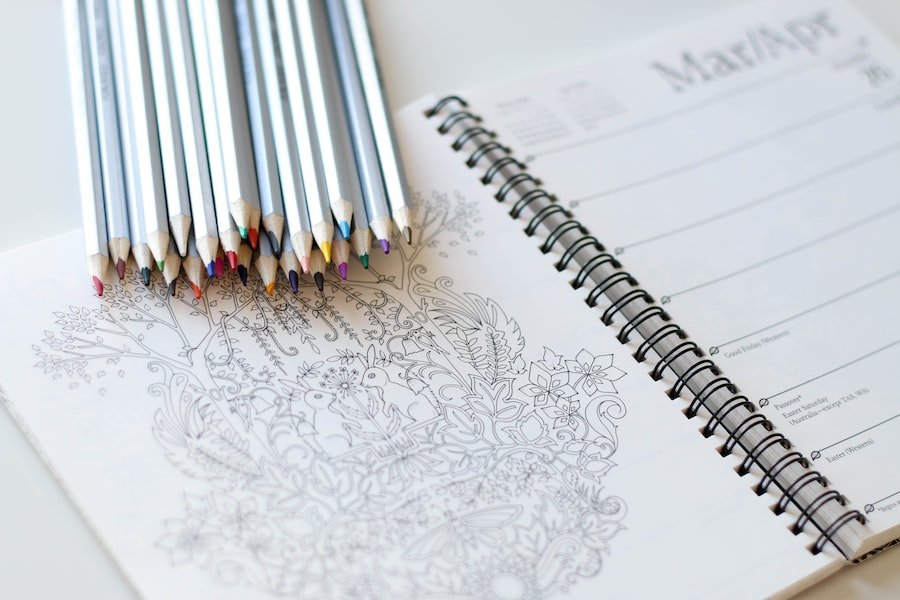Adult coloring books have become increasingly popular in recent years, with people of all ages and backgrounds finding solace and relaxation in the act of coloring. The rise in popularity can be attributed to the therapeutic benefits that coloring provides, as well as the creative outlet it offers. When creating your own coloring book, one of the most important decisions you will make is choosing a theme. The theme sets the tone for your book and determines the types of illustrations and designs you will create. In this article, we will explore the importance of choosing a theme for your coloring book and provide tips on how to select the perfect one.
Choosing a theme for your coloring book
When choosing a theme for your coloring book, there are several factors to consider. First and foremost, you should choose a theme that you are passionate about and that aligns with your interests and expertise. This will ensure that you enjoy the process of creating the illustrations and designs, and it will also make your book more authentic and unique.
Another factor to consider is the target audience for your coloring book. Are you creating a book for children, adults, or both? Different themes will appeal to different age groups, so it’s important to choose a theme that will resonate with your intended audience.
Some popular themes for adult coloring books include nature, animals, mandalas, fantasy, and patterns. These themes offer a wide range of possibilities for creating intricate and detailed designs that are both visually appealing and enjoyable to color. However, don’t be afraid to think outside the box and choose a theme that is less common but still interesting to you.
Sketching out your designs and illustrations
Once you have chosen a theme for your coloring book, it’s time to start sketching out your designs and illustrations. When creating designs that are suitable for coloring, it’s important to keep in mind that they should be intricate enough to provide a challenge, but not so complex that they become overwhelming.
Consider the size of the coloring book and the space available for each design. You want to create illustrations that are large enough to color, but not so large that they take up the entire page. It’s also important to create a variety of designs that offer different levels of difficulty, so that there is something for everyone.
In addition to creating individual designs, it’s important to create a cohesive look throughout the book. This can be achieved by using a consistent color palette, style, or theme for all of your illustrations. This will give your coloring book a professional and polished look, and it will also make it more visually appealing to potential buyers.
Digitizing your drawings for printing
Once you have finished sketching out your designs and illustrations, it’s time to digitize them for printing. This process involves scanning or photographing your drawings and converting them into a digital format that can be easily printed.
There are several tools and software programs available that can help you digitize your drawings. One popular option is Adobe Photoshop, which allows you to scan or photograph your drawings and make any necessary adjustments or edits. Another option is Adobe Illustrator, which is a vector-based program that allows you to create scalable designs that can be resized without losing quality.
When digitizing your drawings, it’s important to ensure that they are high resolution and suitable for printing. This will ensure that the final printed product looks crisp and professional.
Selecting the right paper and printing method
Once your designs have been digitized, it’s time to select the right paper and printing method for your coloring book. The type of paper you choose will depend on several factors, including the type of coloring tools you expect your customers to use (e.g., colored pencils, markers, watercolors) and the desired look and feel of your book.
When selecting paper, consider factors such as weight, texture, and opacity. Heavier weight paper will be more durable and less likely to bleed through, while textured paper can add an interesting dimension to your designs. Opacity is important to prevent colors from bleeding through to the other side of the page.
There are several printing methods available for coloring books, including digital printing and offset printing. Digital printing is a cost-effective option for small print runs, while offset printing is better suited for larger quantities. Consider your budget and the number of copies you plan to print when selecting a printing method.
Adding a title and introduction to your coloring book

Once your designs have been digitized and you have selected the right paper and printing method, it’s time to add a title and introduction to your coloring book. The title is one of the first things potential buyers will see, so it’s important to choose a strong and catchy title that accurately represents the theme and content of your book.
The introduction is an opportunity to provide some background information about your coloring book and explain why you chose the theme. It’s also a chance to engage with your readers and create a connection with them. Consider including a personal story or anecdote that relates to the theme of your book, as this can help create a sense of authenticity and relatability.
Including instructions and tips for coloring
In addition to the designs and illustrations, it’s important to include instructions and tips for coloring in your book. This will help guide your readers and ensure that they get the most out of their coloring experience.
Instructions can include information on how to use different coloring tools, techniques for blending colors, or suggestions for creating different effects. Tips can include advice on choosing colors, shading techniques, or ways to add depth and dimension to their coloring.
Including instructions and tips not only enhances the user experience but also adds value to your coloring book. It shows that you care about your readers’ experience and want to help them create beautiful and satisfying coloring pages.
Testing your coloring book with a focus group
Before publishing your coloring book, it’s important to test it with a focus group. This will allow you to gather feedback and make any necessary revisions or edits before releasing it to the public.
A focus group can consist of friends, family members, or even strangers who are part of your target audience. Provide them with copies of your coloring book and ask for their honest feedback. Ask them about the overall design, the difficulty level of the illustrations, and any suggestions they may have for improvement.
Testing your coloring book with a focus group is an important step in the publishing process, as it allows you to identify any potential issues or areas for improvement. It also gives you an opportunity to gauge the overall reception and interest in your book.
Making any necessary revisions and edits
Based on the feedback from your focus group, it’s time to make any necessary revisions and edits to your coloring book. This may involve adjusting the difficulty level of certain illustrations, adding or removing designs, or making changes to the layout or formatting.
When making revisions and edits, it’s important to keep in mind the overall vision and theme of your coloring book. Make sure that any changes you make are consistent with the style and tone of the rest of the book.
It’s also a good idea to have someone else review your revisions and edits before finalizing your coloring book. A fresh set of eyes can often catch mistakes or inconsistencies that you may have missed.
Deciding on a pricing strategy for your coloring book
Once you have finalized your coloring book, it’s time to decide on a pricing strategy. There are several factors to consider when pricing your book, including the cost of production, the perceived value of your book, and the price range of similar coloring books on the market.
Consider the quality of your paper and printing, as well as the uniqueness and complexity of your designs. These factors can contribute to the perceived value of your coloring book and justify a higher price point.
It’s also a good idea to research the pricing of similar coloring books on the market. This will give you an idea of what customers are willing to pay and help you determine a competitive price for your book.
Promoting and marketing your coloring book to reach your target audience
Once your coloring book is ready for publication, it’s important to promote and market it to reach your target audience. There are several strategies you can use to promote your book, including social media marketing, email marketing, and collaborations with influencers or bloggers in your niche.
Social media platforms such as Instagram, Facebook, and Pinterest are great tools for showcasing your designs and reaching a wide audience. Create engaging and visually appealing posts that highlight the unique features of your coloring book and encourage followers to share their colored pages using a specific hashtag.
Email marketing is another effective way to promote your coloring book. Build an email list of interested customers and send regular updates about your book, including sneak peeks, special offers, and behind-the-scenes content.
Collaborating with influencers or bloggers in your niche can help you reach a larger audience and build credibility for your coloring book. Reach out to influencers who have a similar target audience and offer them a free copy of your book in exchange for an honest review or feature on their platform.
Creating and publishing a coloring book can be a rewarding and fulfilling experience. By choosing a theme that you are passionate about, sketching out cohesive designs, digitizing your drawings, selecting the right paper and printing method, adding a title and introduction, including instructions and tips for coloring, testing with a focus group, making revisions and edits, deciding on a pricing strategy, and promoting and marketing your book, you can create a successful coloring book that resonates with your target audience.
So, what are you waiting for? Start creating your own coloring book today and unleash your creativity!
If you’re interested in creating your own coloring book, you may also want to check out this article on “How to Print Your Own Coloring Book.” This informative guide provides step-by-step instructions on how to design and print your coloring book, ensuring that your artwork looks professional and vibrant. Whether you’re planning to sell your coloring book on Amazon or create it as a fun activity for friends and family, this article will give you all the tips and tricks you need to bring your creative vision to life. Read more
FAQs
What is a colouring book?
A colouring book is a book containing line drawings or illustrations that are intended to be filled in with coloured pencils, markers, crayons, or other coloring materials.
What materials do I need to make a colouring book?
To make a colouring book, you will need paper, a printer, a computer, drawing tools, and software for editing and formatting your drawings.
How do I create the drawings for my colouring book?
You can create your drawings by hand using traditional drawing tools like pencils, pens, and markers, or you can use digital drawing software like Adobe Illustrator or Procreate.
How do I format my drawings for a colouring book?
To format your drawings for a colouring book, you will need to scan or photograph your drawings and then use software like Adobe Photoshop or InDesign to adjust the size, resolution, and layout of your images.
How do I print and bind my colouring book?
To print and bind your colouring book, you can use a print-on-demand service like Amazon’s CreateSpace or IngramSpark, or you can print and bind your book yourself using a home printer and binding machine.
What are some tips for making a successful colouring book?
Some tips for making a successful colouring book include choosing a theme or subject that will appeal to your target audience, creating high-quality and engaging illustrations, and promoting your book through social media and other marketing channels.
















